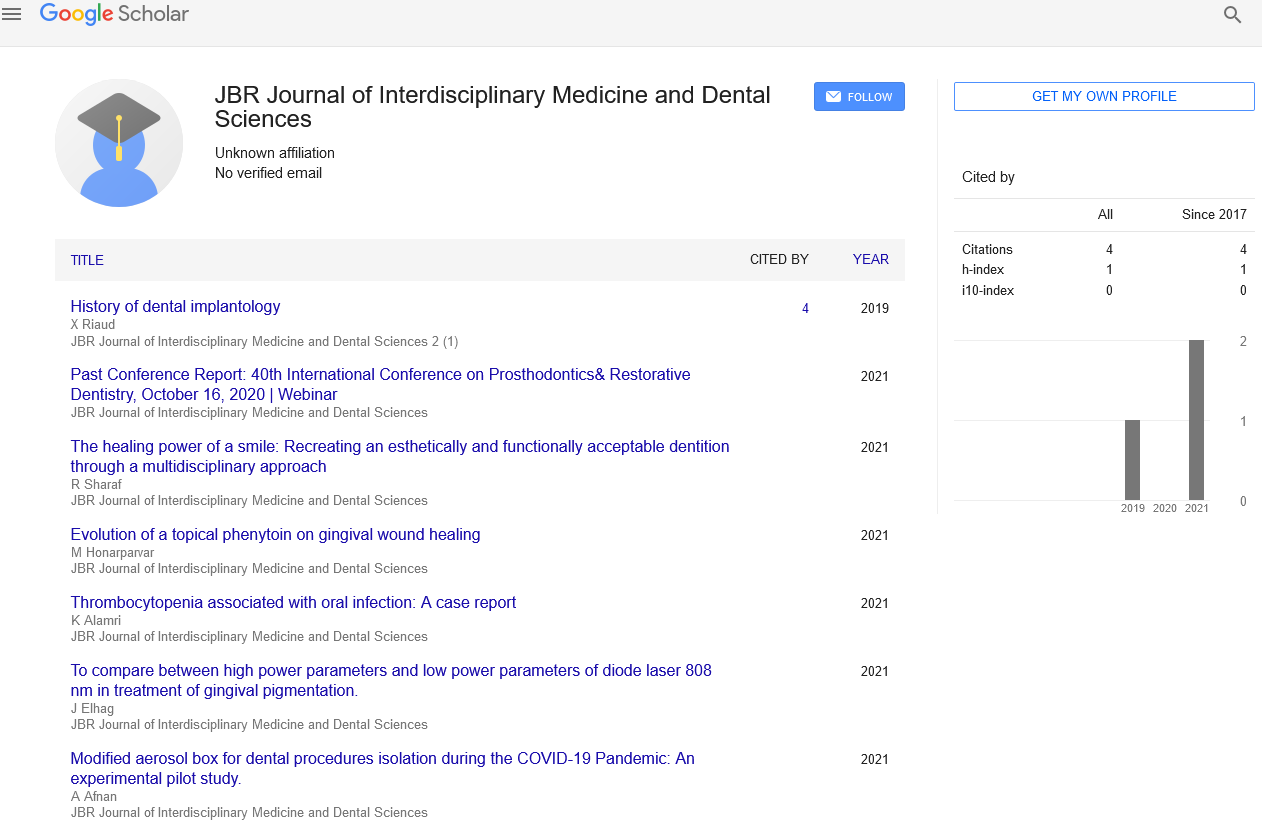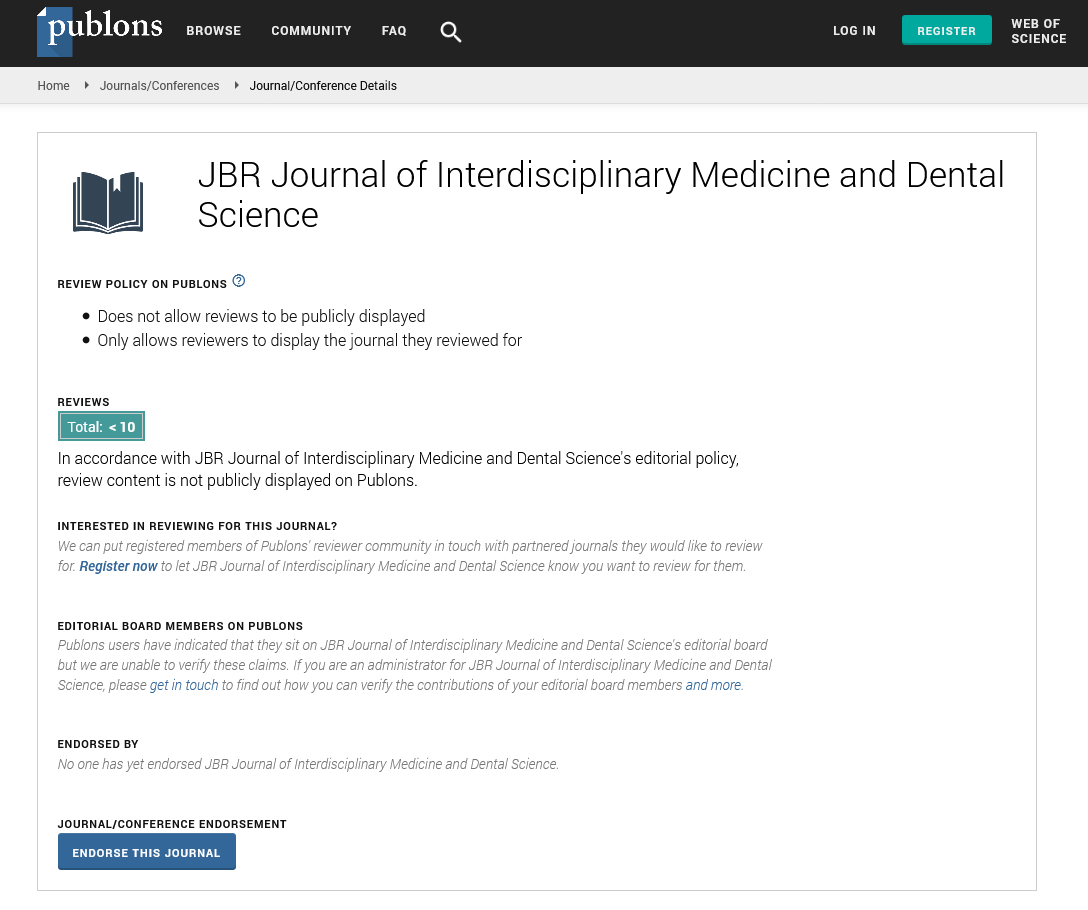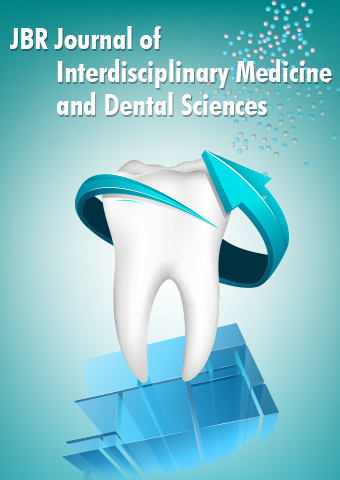Editorial - JBR Journal of Interdisciplinary Medicine and Dental Sciences (2023) Volume 6, Issue 3
Periodontology Understanding: the Importance of Gum Health
Naitik Sharma*
Department of pharmacology, India
Department of pharmacology, India
E-mail: sharma_nk83@gmail.com
Received: 01-May-2023, Manuscript No. jimds-23-100150; Editor assigned: 04-May-2023, PreQC No. jimds-23-100150 (PQ); Reviewed: 19-May-2023, QC No. jimds-23-100150; Revised: 24-May-2023, Manuscript No. jimds-23-100150 (R); Published: 31-May-2023, DOI: 10.37532/2376- 032X.2023.6(3).49-51
Abstract
Periodontology, a branch of dentistry focused on the health of supporting structures around the teeth, plays a crucial role in maintaining overall oral health and general wellbeing. This article explores the significance of gum health, common periodontal diseases, and available treatments. Healthy gums act as a protective barrier, but poor oral hygiene leads to plaque build-up and gum disease. Gum disease, if left untreated, progresses from gingivitis to periodontitis, affecting the surrounding tissues and bone. Moreover, gum health is linked to systemic conditions like cardiovascular disease and diabetes. Understanding common periodontal diseases such as gingivitis, chronic periodontitis, aggressive periodontitis, and periodontal abscess helps identify symptoms and seek appropriate treatment. Non-surgical interventions like professional dental cleaning, antimicrobial rinses, and antibiotics can control mild to moderate gum disease, while surgical treatments like flap surgery and grafting restore gum health in advanced cases. Regular maintenance visits and proper oral hygiene practices are vital for preventing gum disease. Overall, maintaining healthy gums is crucial for oral and overall health.
Keywords
Periodontology • Gum health • Gingivitis • Periodontitis • Plaque • Oral Hygiene
Introduction
Periodontology, a specialized branch of dentistry known as periodontics, focuses on the prevention, diagnosis, and treatment of diseases that affect the supporting structures of the teeth, including the gums, bones, and connective tissues [1]. The health of our gums is of paramount importance in maintaining overall oral health and has a significant impact on our general well-being. In this article, we will delve into the world of periodontology, exploring the importance of gum health, the prevalence and impact of periodontal diseases, and the various treatments available to address these conditions [2]. Healthy gums play a vital role in supporting and protecting our teeth. When the gums are in good health, they are firm, pink, and fit snugly around the teeth, forming a protective barrier. However, neglecting proper oral hygiene practices can lead to the accumulation of plaque, a sticky film composed of bacteria, which can cause gum disease. Gum disease, also known as periodontal disease, is a progressive condition that typically begins with gingivitis. Gingivitis is characterized by inflamed gums that may appear red, swollen, and tends to bleed easily. If left untreated, gingivitis can progress to periodontitis, a more advanced stage of gum disease [3]. During periodontitis, the infection spreads from the gums to the surrounding tissues and bone, resulting in gum recession, tooth mobility, and, in severe cases, tooth loss. The impact of gum disease extends beyond the oral cavity. Numerous studies have shown a strong association between periodontal disease and various systemic conditions, including cardiovascular disease, diabetes, respiratory infections, and adverse pregnancy outcomes. Maintaining healthy gums is not only essential for preserving our natural teeth but also for safeguarding our overall health. In this article, we will explore the common periodontal diseases, including gingivitis, chronic periodontitis, aggressive periodontitis, and periodontal abscess [4]. We will delve into their symptoms, progression, and potential consequences if left untreated. Furthermore, we will discuss the available treatments, ranging from non-surgical approaches such as professional dental cleaning and antimicrobial rinses to surgical interventions like flap surgery and tissue regeneration. Finally, we will emphasize the importance of regular maintenance visits to the dentist or periodontics for long-term gum health and prevention of disease recurrence [5].
Additionally, we will highlight the significance of practicing proper oral hygiene, including regular brushing, flossing, and the use of antimicrobial mouthwashes, to maintain optimal gum health. By understanding the significance of gum health, the common periodontal diseases, and the available treatments, we can proactively prioritize our oral hygiene and take necessary steps to prevent and address gum disease, ensuring both a healthy smile and overall well-being.
Discussion
Periodontology, also known as periodontics, is a branch of dentistry that focuses on the prevention, diagnosis, and treatment of diseases that affect the supporting structures of the teeth, including the gums, bones, and connective tissues. The health of our gums plays a crucial role in maintaining overall oral health and has a significant impact on our general well-being. In this article, we will delve into the world of periodontology, exploring the importance of gum health, common periodontal diseases, and available treatments.
The significance of gum health
The gums, or gingiva, serve as a protective barrier around the teeth, providing support and preventing harmful bacteria from reaching the underlying structures. When the gums are healthy, they are firm, pink, and fit snugly around the teeth [6]. However, poor oral hygiene practices can lead to the accumulation of plaque, a sticky film of bacteria, which can cause gum disease. Gum disease, or periodontal disease, is a progressive condition that begins with gingivitis, characterized by inflamed gums that bleed easily. If left untreated, gingivitis can progress to periodontitis, where the infection spreads to the surrounding tissues and bone, leading to gum recession, tooth mobility, and even tooth loss. The impact of gum disease extends beyond the oral cavity [7]. Numerous studies have shown a strong association between periodontal disease and systemic conditions such as cardiovascular disease, diabetes, respiratory infections, and adverse pregnancy outcomes. Maintaining healthy gums is not only essential for preserving our natural teeth but also for safeguarding our overall health.
Common periodontal diseases
Gingivitis: This is the earliest and mildest form of gum disease. It occurs when plaque build-up along the gumline causes inflammation, leading to red, swollen, and easily bleeding gums. With proper oral hygiene and professional dental care, gingivitis is reversible [8].
Chronic periodontitis: This is the most common form of gum disease and typically develops when gingivitis is left untreated. It involves the progressive destruction of the gums, bone, and connective tissues that support the teeth. Symptoms include gum recession, pocket formation (spaces between the gums and teeth), bad breath, and tooth mobility.
Aggressive periodontitis: This form of gum disease usually affects young individuals and is characterized by rapid bone and tissue loss. It tends to run in families and may be associated with a weakened immune system.
Periodontal abscess: An abscess is a localized infection that forms within the periodontal pocket. It is often accompanied by swelling, pain, and discharge of pus [9]. Prompt treatment is necessary to alleviate symptoms and prevent the spread of infection.
Available treatments
The treatment of gum disease depends on the severity and progression of the condition. It may involve a combination of the following approaches:
Non-surgical treatments: In mild to moderate cases of gum disease, non-surgical interventions such as professional dental cleaning (scaling and root planning), antimicrobial rinses, and local antibiotic therapy may be sufficient to control the infection and promote gum healing [10].
Surgical treatments: In advanced cases, surgical intervention may be necessary to restore gum health. Procedures like flap surgery, bone grafting, tissue regeneration, and gum grafting can help repair and regenerate damaged tissues, reduce pocket depths, and stabilize loose teeth.
Maintenance
Once gum disease has been treated, regular maintenance visits to the dentist or periodontics are crucial to monitor the condition and prevent recurrence. Proper oral hygiene practices, including regular brushing, flossing, and the use of antimicrobial mouthwashes, should be followed diligently.
Conclusion
Periodontology, the branch of dentistry dedicated to gum health, highlights the importance of maintaining healthy gums for overall oral health and general well-being. Gum disease, if left untreated, can lead to significant oral and systemic health problems. Therefore, understanding common periodontal diseases such as gingivitis and periodontitis is crucial in recognizing their symptoms and seeking appropriate treatment. Through non-surgical interventions like professional dental cleaning and antimicrobial rinses, mild to moderate gum disease can be effectively controlled. For advanced cases, surgical treatments such as flap surgery and tissue regeneration play a vital role in restoring gum health and preventing further damage. Regular maintenance visits to the dentist or periodontics, combined with proper oral hygiene practices, form the cornerstone of preventing gum disease and maintaining optimal gum health. Moreover, the relationship between gum disease and systemic conditions like cardiovascular disease and diabetes underscores the significance of gum health beyond oral health. By prioritizing gum health and seeking timely treatment, individuals can reduce the risk of both oral and systemic health complications. Ultimately, periodontology serves as a reminder of the crucial role that gum health plays in our overall well-being. By staying informed about the importance of gum health, recognizing the signs of gum disease, and proactively seeking appropriate treatment, we can preserve our natural teeth, promote oral health, and contribute to our overall quality of life.
References
- Tonesk X, Buchanan RG. An AAMC pilot study by 10 medical schools of clinical evaluation of students. J Med Educ. 62, 707–718 (1998).
- Mays N, Pope C. Qualitative research in health care. Assessing quality in qualitative research. BMJ. 320, 50–52 (2000).
- Kassebaum DG, Eaglen RH. Shortcomings in the evaluation of students’ clinical skills and behaviors in medical school. Acad Med. 74, 842–849 (1999).
- Siminoff LA, Zhang A, Colabianchi N et al. Factors that predict the referral of breast cancer patients onto clinical trials by their surgeons and medical oncologists. J Clin Oncol. 18, 1203– 1211 (2000).
- Ross S, Grant A, Counsell C et al. Prescott RJ. Barriers to participation in randomised controlled trials. J Clin Epidemiol. 52, 1143– 1156 (1999).
- Ding EL, Song Y, Malik VS et al. Sex differences of endogenous sex hormones and risk of type 2 diabetes. Jama. 295,1288-1299 (2006).
- Mohammed M, Al-Habori M, Abdullateef A et al. Impact of metabolic syndrome factors on testosterone and SHBG in type 2 diabetes mellitus and metabolic syndrome. J Diabetes Res. 492, 78-98 (2018).
- Malipatil NS, Yadegarfar G, Lunt M et al. 14-year prospective outcome in 550 men with type 2 diabetes. Endocrinol Metab. 2, 3-4 (2019).
- Kelsey MM, Bjornstad P, McFann K et al. Testosterone concentration and insulin sensitivity in young men with type 1 and type 2 diabetes. Pediatr Diabetes. 17,184-190 (2016).
- Juneja R, Palmer JP. Type 1 1/2 diabetes: myth or reality? J Autoimmun. 29, 65-83 (2009).
Indexed at, Google Scholar, Crossref
Indexed at, Google Scholar, Crossref
Indexed at, Google Scholar, Crossref
Indexed at, Google Scholar, Crossref
Indexed at, Google Scholar, Crossref
Indexed at, Google Scholar, Crossref
Indexed at, Google Scholar, Crossref
Indexed at, Google Scholar, Crossref
Indexed at, Google Scholar, Crossref


